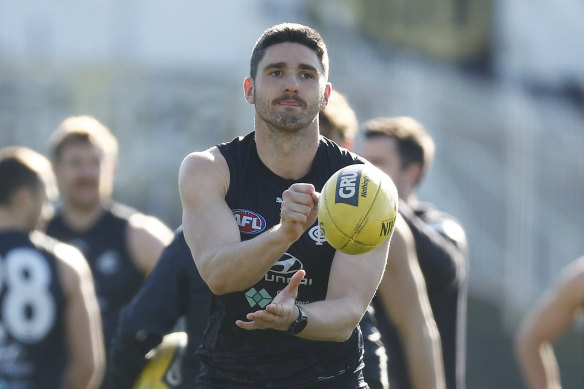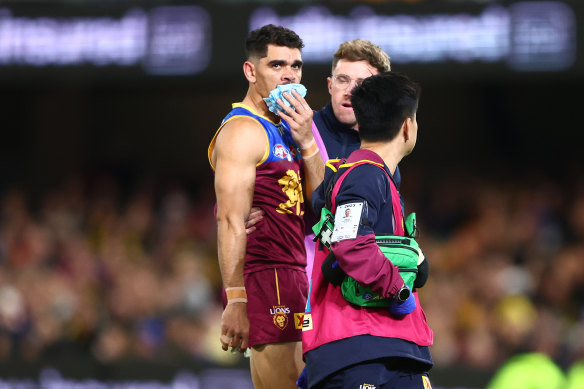Carlton’s tall order as Pittonet returns; Cameron’s confidence back after brutal blow
Save articles for later
Add articles to your saved list and come back to them any time.
In today’s AFL briefing, your daily wrap of footy news:
- Carlton will take a two-pronged ruck division into Friday night’s elimination final against Sydney at the MCG, with Marc Pittonet to play alongside Tom De Koning despite a forecast for rain.
- A collision with Richmond’s Trent Cotchin in round 16 cost Charlie Cameron two front teeth, with the Lion admitting his confidence had been affected in the aftermath.
Tall order: Pittonet brought in for Blues back-up
AAP
Carlton will take a two-pronged ruck division into Friday night’s elimination final against Sydney at the MCG, with Marc Pittonet to play alongside Tom De Koning despite a forecast for rain.
The important selection call comes after coach Michael Voss experimented with key forward Harry McKay as a back-up to De Koning in round 24, when the Blues lost to GWS.
McKay will spend more time in attack alongside back-to-back Coleman medallist Charlie Curnow, with Pittonet set to add a physical presence around the ball in predicted tough conditions against Swans pair Tom Hickey and Hayden McLean.
“We feel like that’s been a real strength of ours throughout this year,” Voss said of his ruck pairing. “They bounce off each other really well and they’re obviously pretty good at their own individual roles, but we feel like we lean into our strengths there.”
Carlton ruckman Marc Pittonet is back for the elimination final against the Swans.Credit: Getty Images
Carlton captain Patrick Cripps and Sam Docherty will return after a week off for the elimination final, while wingman Blake Acres is available to play despite hurting his shoulder in round 24.
Friday night will be Carlton’s first finals appearance since 2013 and Voss declared the event partly a celebration for the Blues and their supporters. “We want all that noise, we want that real positive energy and we want to put smiles on faces,” Voss said. “To do that, we’ve got to get out and get our jobs done.”
The elimination final will be played in frigid temperatures as the mercury plummets in Melbourne, with the Bureau of Meteorology expecting hail and rain on Friday with the day-time temperature to hover between just seven and a top of 12.
The temperature is predicted to stay in single figures, but the “feels-like” temperature will be much lower, dropping to just one degree. On its website, the BoM explains the concept of its “feels-like” measure, otherwise known as apparent temperature.
“Our instruments measure ‘ambient temperature’ – how warm the air is in the shade and sheltered from the wind. But by taking into account wind and humidity we also calculate ‘apparent temperature’ – how warm you might feel. There can be a considerable difference between the two,” the bureau says.
The Blues endured a rough start to Voss’ second year at the helm and looked out of contention with a 4-1-8 record halfway through the bye rounds.
A fierce blowtorch was turned on the coach and his players, who were jeered off the ground by long-suffering fans after several poor performances.
But a stunning nine-match winning streak, which was ended by GWS in round 24 when Voss rested some key players, propelled the Blues into September. They are warm favourites to win against Sydney, expecting the bulk of support from a crowd tipped to reach 90,000 at the MCG.
Cameron’s confidence rebounds after brutal blow
Andrew Stafford
On Saturday night at the Gabba, Charlie Cameron will line up for his 200th game. Coming into the qualifying final against Port Adelaide, and in a talent-stacked Brisbane Lions team led by 2020 Brownlow medallist Lachie Neale, the 29-year-old Lardil and Waanyi man from Mornington Island is the ace in the Lions pack.
Cameron is the rarest of small forwards in the modern game in that his explosivity is matched by an underrated level of consistency. In six seasons with the Lions since crossing from Adelaide, he has failed to top 50 goals just twice: in the COVID-shortened season of 2020, and his first season with the club (2018), which was cut short by an ankle injury.
He’s played 115 consecutive games since – the third-highest streak in the league behind Collingwood’s Jack Crisp (211) and Melbourne’s Christian Petracca (130). That speaks as much to high standards of preparation and recovery as it does to good luck, and Cameron was rewarded for his 53 goals this season with his second All-Australian jacket last week.
Charlie Cameron leaves the field after losing two teeth against Richmond.Credit: AFL Photos
That run was nearly broken in round 16, after a collision with Richmond’s Trent Cotchin cost him two front teeth. Cameron admitted his confidence had been affected in the aftermath. “I had a patch of six weeks where I wasn’t playing up to the standard,” he said on Thursday. “I just tried to block it out, I think I was worrying about it too much.”
Having set himself for finals, Cameron shapes as one of the key players in September. He is as much a barometer for the Lions as Jordan De Goey is to Collingwood, Toby Greene is to GWS or Charlie Curnow to Carlton. His finals record is elite: in 16 matches, he’s kicked 34 goals, above his career average of 1.78 a game.
And Cameron is no downhill skier. In the qualifying final of 2021, when the Lions were soundly beaten by premiers Melbourne, he kicked five goals. In the subsequent semi-final, in which the Lions lost by a point to eventual runners-up the Western Bulldogs, Cameron slotted three goals, handed off another three assists and laid five tackles.
He has also won matches off his own boot. It was in the 2017 preliminary final, playing for Adelaide, that Cameron served notice that he was an emerging star of the competition, kicking five goals from 19 disposals to destroy Geelong. Last year, he kicked three goals in both the elimination and semi-finals to snatch narrow victories over Richmond and Melbourne.
Cameron, remember, plays in the toughest position on the ground to get a kick: forward pocket, otherwise known as starvation corner. In the heightened intensity of finals – where close to 200 tackles might be laid in the course of a match – the most highly skilled players are swarmed before they can find space.
“I think you’ve just got to give yourself opportunities where you can get involved early,” Cameron said. “That’s something I look to do in finals, get involved early so you can get some confidence, so to make the most of opportunities when they come around … I just try to keep it as simple as possible.”
Cameron only needs half an opportunity to bend a game to his will. Like Cyril Rioli, he can exert a profound impact on the contest with a handful of possessions (five in last year’s semi-final against Melbourne yielded 3.1). This ability to make things happen also brings crowds into the game. With the Lions guaranteed two home finals, that will be vital.
Also like Rioli, Cameron instils fear in opponents going the other way. He ranks second in the competition this year for tackles inside 50, just one behind Melbourne’s Kysaiah Pickett. His chase-and-tackle pressure creates opportunities for the Lions’ other small and medium forwards Lincoln McCarthy, Cam Rayner and Zac Bailey.
“I think over the last two years I’ve had a real focus on that,” he said. “I’ve tried to set myself goals to be the No.1 forward-50 tackler in the game, so I just try to bring that pressure and everything else will flow on from that.”
Keep up to date with the best AFL coverage in the country. Sign up for the Real Footy newsletter.
Most Viewed in Sport
From our partners
Source: Read Full Article


